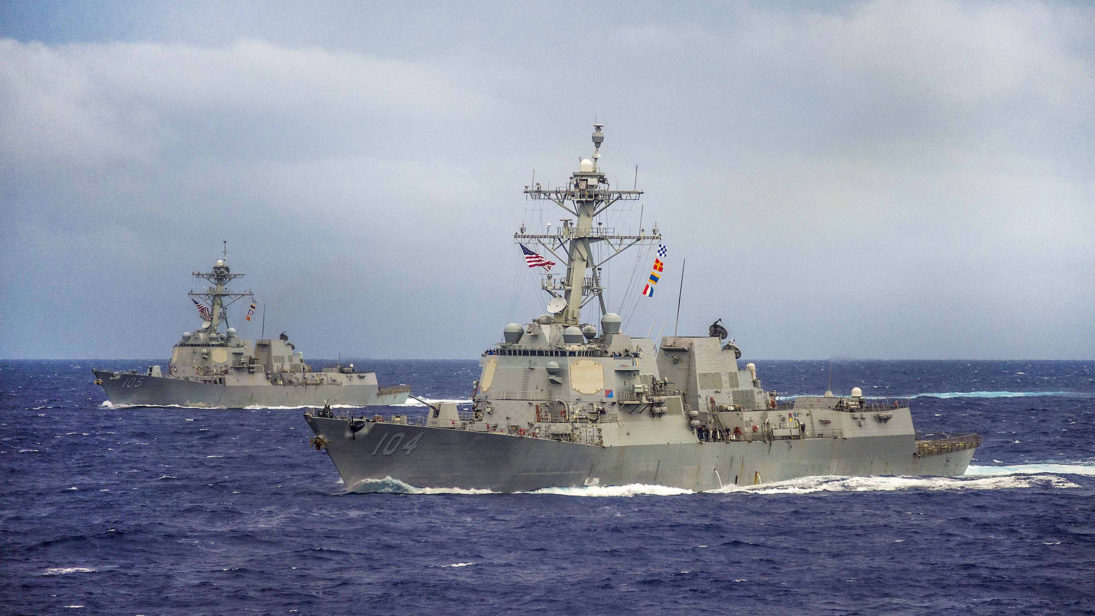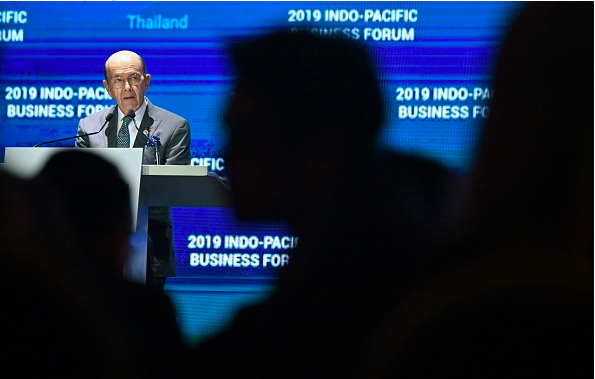
The concept of the Indo-Pacific has emerged from an evolving mental map of the increasingly contiguous Indian and Pacific Oceans, as well as the growing economic interdependence of states within the region. However, the Indo-Pacific is also a political entity best understood as a case of two rivalries on either end of the region. In the Western Pacific, the rivalry is between the United States and China, and in the Indian Ocean, Sino-Indian competition shapes strategic calculations. These distinct rivalries—and the emerging interactions between them—are likely to decide the geopolitics of the region.
Sino-U.S. Rivalry in the Western Pacific
In the Western Pacific, the rivalry is between the United States and China, and in the Indian Ocean, Sino-Indian competition shapes strategic calculations. These distinct rivalries—and the emerging interactions between them—are likely to decide the geopolitics of the region.
The Sino-U.S. rivalry in the Western Pacific is a case of the inherent tensions arising from an emerging superpower (China) challenging a reigning one (the United States). By flexing its muscles in the Western Pacific, especially in the South China Sea, China poses a threat to U.S. dominance in two ways. First, China’s territorial claims have been a direct negation of U.S. presence in the region. Through the missiles and naval forces Beijing has acquired and/or developed in recent years, its anti-access/area-denial capabilities could circumvent and push back on U.S. influence in the region. Beijing’s approach is also a major challenge for the United States’ bid to uphold the principle of freedom of navigation in the waters of the South China Sea.
Second, China’s Belt and Road Initiative (BRI) could alter the foundations of U.S. dominance in the modern international order through a geoeconomic offensive. China’s BRI is a concerted plan to influence regional actors through both economic incentives as well as coercive measures. Therefore, BRI presents smaller states in the Indo-Pacific with a unique dilemma: although China is economically coercive, BRI provides these states with opportunities for better connectivity and modernization. In such a regional landscape, where small states cannot remain isolated and cannot challenge Beijing on their own, they are struggling to find an alternative to China. The United States and its partners do not yet have a comprehensive alternative to BRI. Although Washington is gradually putting more emphasis on the economic dimension of its Indo-Pacific policy through efforts such as the BUILD Act and the Asia EDGE initiative, these efforts lack the financial merit to meaningfully counter China-led plans or fulfill U.S. objectives. The crux of the issue in the region is this: China is emerging as a politically indispensable force and a financial powerhouse while the United States, the erstwhile leader, is simultaneously fading.
Sino-Indian Rivalry in the Indian Ocean
One of the trends of the last decade in Asian geopolitics has been the rising footprint of China in the Indian Ocean, where India is a resident power. China’s primary objective in the Indian Ocean is to ensure that all of its energy trade and shipping traffic passes securely through its sea lanes. But Beijing also has aspirations to project power in the region, and it has developed a two-pronged strategy to do so. First, China has been developing relationships and partnerships with the Indian Ocean littoral states, many of which include India’s neighbors, in order to further its position in the region through the establishment of military bases. Second, China has been deploying assets in the IOR—for both incremental control in the region as well as to gauge the operational environment in an effort to be ready in case of an emerging conflict.
Concerned about China encircling its coastline and wooing its neighbors with offers of connectivity and economic development, India is aiming to counterbalance Chinese efforts by: (1) deepening relations with Indian Ocean littoral states and putting its “neighborhood first” (2) engaging with favorable extra-regional actors such as the United States, France, and Japan; and (3) arguing for an inclusive and multipolar region to undercut any tendencies of hierarchical power equations.
In contrast to Sino-U.S. dynamics in the Western Pacific, the Sino-Indian rivalry in the Indian Ocean takes the form of a security dilemma. In this particular situation, rivals cannot clearly distinguish between defensive and offensive actions. As offensive measures have an inherent advantage, skepticism begets an arms race. For instance, China claims that the ports it is establishing in littoral nations are not strategic, but rather for civilian/commercial purposes. However, China’s continued incursions in the South China Sea and the history of Sino-Indian mistrust due to their border dispute leads to uncertainties in New Delhi. In turn, India has developed a proactive approach to emerge as a net security provider in the region, which might be perceived as an offensive measure by China. Against this backdrop, China in turn may try to overcompensate for its lack of geographical proximity to the IOR by flexing its economic and military muscles in the region. These actions once again make India concerned about encirclement or losing influence in its own region. The downward spiral is evident and in the midst of this security dilemma, the Indian Ocean has become a flashpoint where India and China are competing for regional influence.

Trends for the Future
With the United States identifying China as its main strategic competitor in its National Defense Strategy last year, and India’s increased diplomatic, economic, and defense engagement with South East Asia and IOR littorals, alongside efforts by powers like Australia and Japan to balance China, the region may be heading towards steeper competition.
What do these rivalries mean for the region and how might they interact with each other? Looking at the region through the United States-China and India-China regional contestations underlines a crucial point: in the future, the Indo-Pacific region is likely to be characterized more by competition than cooperation. Since China’s concerns in the Western Pacific and the Indian Ocean are tied to sovereignty and securing its economic interests, its advances in these waters are likely to grow with time. On the other hand, Washington interests’ in the Western Pacific and the Indian Ocean are about preserving the rules of the order it has led through the years. Thus, its support for like-minded partners such as India, which has been a proponent of the same principles of freedom of navigation and a free and open Indo-Pacific, is likely to grow and would take the form of an enhanced maritime partnership with New Delhi, to balance against Beijing. Even independent of the United States, India has recognized the long-term Chinese threat to its interests in its own backyard.
However, the United States-India partnership to counter China faces some hurdles. Firstly, though both recognize the challenges China poses in the Indo-Pacific, Washington and New Delhi’s interests in the region and how it is defined do not fully converge. This has restricted the United States’ Indo-Pacific strategy to the Western Pacific, largely leaving out the Indian Ocean, while India’s presence beyond the Straits of Malacca has been nominal and symbolic. Secondly, even though the Indian Ocean is its primary area of interest, India has to play according to its capabilities. While it is aware of what’s at stake in the IOR, it cannot overplay its hand and risk instigating China, with which it has a power differential and a lingering border dispute.
With regard to how these two rivalries might impact the region, they are likely to provide multiple options to regional actors, especially small states, to hedge against China. In the Western Pacific, smaller nations favor U.S. military presence to balance Chinese might, but find it difficult to stay away from the economic opportunities created by China. In the Indian Ocean, the littoral states, scrambling for connectivity and development, have been using China as a bargaining chip to balance India. However, with the United States identifying China as its main strategic competitor in its National Defense Strategy last year, and India’s increased diplomatic, economic, and defense engagement with South East Asia and IOR littorals, alongside efforts by powers like Australia and Japan to balance China, the region may be heading towards steeper competition. Already the United States is gradually looking for opportunities to advance into the Bay of Bengal while India is projecting influence beyond its immediate arc. If these trends hold, the United States-China and China-India rivalries may pose challenges to Beijing’s advances in the region.
***
Image 1: U.S. Indo-Pacific Command
Image 2: Romeo Gacada via Getty Images


